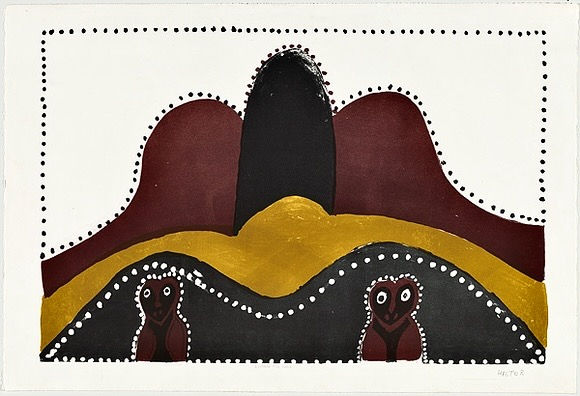HECTOR JANDANY
Hector Jandany (1929 - 2006)
Dumbun - The Owls, 2001
76 x 112 cm. Lithograph on paper, edition: 6/40.
(81 x 118 cm Framed)
ARTIST
Hector Jandany (c. 1927–2006) was a prominent Gija artist from Warmun (Turkey Creek) in the Kimberley region of Western Australia. His work is celebrated for its deep connection to his ancestral lands and the rich cultural traditions of his people.
Born around 1927, Jandany experienced significant hardships early in life, including the loss of his father during his infancy. He was raised by his mother and stepfather, a stockman whom he greatly admired. Jandany spent much of his youth working as a stockman and cook on various cattle stations, including Texas Downs. These experiences provided him with an intimate understanding of his ancestral country, particularly the Bungle Bungles (Purnululu), which later became central themes in his art.
In 1979, Jandany became the director of the Bough Shed School in Warmun. In this role, he was instrumental in integrating Gija cultural teachings into the school's curriculum, ensuring that traditional knowledge and stories were passed down to younger generations.
Jandany began painting later in life, drawing inspiration from his deep-rooted connection to his mother's country and the Dreaming stories of the Ngarrgoorroon region. His artworks are characterized by the use of natural ochres and pigments, reflecting the earthy tones of the Kimberley landscape. He often employed restrained color palettes and minimalist compositions to convey complex narratives and spiritual themes. His paintings have been featured in numerous exhibitions since 1990 and are held in significant collections, including the National Gallery of Australia.
WORK
This print depicts Goonawayinji (Pocket Springs) in Ngarrgooroon, the artist’s traditional country east of Warmun (Turkey Creek), Western Australia. This site is associated with the Owl (Dumbun) Dreaming.
In the Dreamtime, two owls entered a cave (nawan) at this location, where they watched two young boys who had stolen food from Boodarril, the Lizard. The owls flew away and informed Boodarril of the boys' misdeed. Enraged, Boodarril declared, “Well, we'll punish them... We have to lock them up!”
Boodarril then approached another being, Galooring, who had the power to open a large black rock. Once the rock was open, Boodarril captured the boys and commanded them to enter. As soon as they stepped inside, the rock closed over them—trapping them forever.
Today, this sacred place is marked by a natural spring (Pocket Springs), where bamboo used for crafting spear shafts grows abundantly.
In the print, the two owls are shown at the bottom inside the cave. The central hill represents the location of the cave, while the surrounding hills depict the broader landscape of the area.

